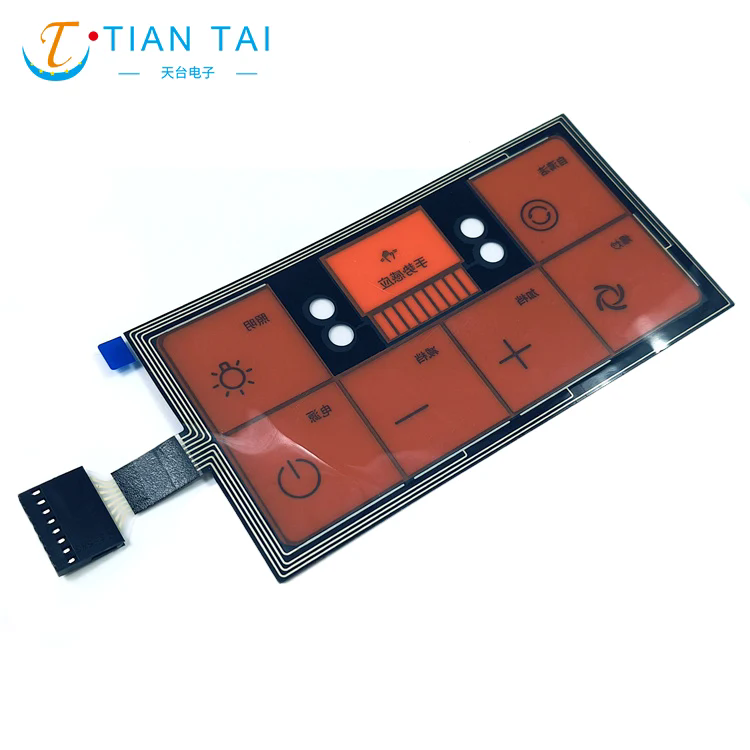Why Are Capacitive Touch Membrane Switches Redefining Modern Interfaces?
2024-12-03
In the age of sleek, intuitive technology, the capacitive touch membrane switch has emerged as a standout solution for modern interfaces. Found in everything from consumer electronics to industrial machinery, these switches combine functionality and aesthetics, delivering unparalleled user experiences. But what exactly makes capacitive touch membrane switches so revolutionary?
What Is a Capacitive Touch Membrane Switch?
A capacitive touch membrane switch is a user interface technology that detects touch through changes in capacitance. Unlike traditional mechanical switches, it doesn’t require physical pressure to function. Instead, the switch responds to the natural conductivity of the human body, allowing for a smooth, touch-sensitive interaction.
These switches typically consist of multiple layers, including a printed circuit, a sensing layer, and a protective top surface. When a finger comes into contact with the switch, it alters the electrical field, triggering a response.
Key Features of Capacitive Touch Membrane Switches
1. Seamless Design
Capacitive touch switches offer flat and sleek surfaces, which can be seamlessly integrated into modern devices. They often feature customizable graphics, colors, and backlighting for an attractive appearance.
2. High Sensitivity
The switches detect even the slightest touch, ensuring quick and reliable responses.
3. Durability
With no moving parts, capacitive switches are more durable and resistant to wear and tear compared to mechanical counterparts.
4. Water and Dust Resistance
Many capacitive touch switches are sealed, making them suitable for environments prone to moisture, dust, or other contaminants.
5. Customizable Functionality
These switches can be tailored to include multi-touch capabilities, gesture recognition, and proximity sensing for enhanced interactivity.
Applications of Capacitive Touch Membrane Switches
1. Consumer Electronics
Devices such as smartphones, tablets, and smart home controls rely on capacitive touch technology for their intuitive and visually appealing interfaces.
2. Medical Devices
Capacitive switches are ideal for medical equipment due to their easy-to-clean surfaces and precise touch detection.
3. Industrial Equipment
In manufacturing and automation, these switches provide reliable performance in rugged environments, often featuring backlit keys for visibility in low-light conditions.
4. Appliances
Home appliances like ovens, washing machines, and refrigerators use capacitive touch switches for sleek and functional control panels.
5. Automotive Interfaces
Modern vehicles employ these switches for infotainment systems, climate controls, and other interactive features, offering a futuristic driving experience.
Benefits of Capacitive Touch Membrane Switches
1. Improved User Experience
The smooth, responsive surface enhances ease of use, providing a high-tech feel that users appreciate.
2. Enhanced Reliability
With no mechanical components, the switches are less prone to failure, ensuring long-term reliability.
3. Design Flexibility
Capacitive switches can be customized to fit various shapes, sizes, and functions, making them adaptable to different applications.
4. Safety and Hygiene
The sealed design prevents contaminants from entering, making them easy to disinfect, which is particularly important in medical and food processing industries.
5. Energy Efficiency
These switches consume minimal power, making them suitable for battery-operated devices.
Challenges of Capacitive Touch Membrane Switches
Despite their advantages, capacitive touch switches have a few limitations:
- Higher Initial Cost: The advanced technology can be more expensive than traditional switches.
- Limited Use with Gloves: Standard capacitive switches may not work with gloved hands unless designed for such use.
- Environmental Sensitivity: Extreme temperatures or high humidity can sometimes affect performance.
Future Trends in Capacitive Touch Technology
As technology evolves, capacitive touch membrane switches are becoming even more sophisticated. Emerging trends include:
- Integration with IoT: Advanced switches can now connect to smart systems, offering real-time data and remote control capabilities.
- Enhanced Durability: New materials and coatings are improving resistance to extreme conditions, further broadening their applications.
- Multi-Layered Interfaces: Future designs will integrate touch, gesture, and force sensing for more dynamic interactions.
Conclusion
Capacitive touch membrane switches are redefining the way we interact with devices, offering sleek, durable, and responsive interfaces that cater to the demands of modern technology. From industrial machinery to personal gadgets, their versatility and reliability make them an essential component of today’s electronic systems.



